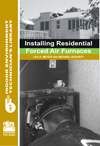Thermostats have gotten seriously smart in the last decade. In addition to their traditional role of sensing temperature and powering the HVAC system on or off, units from Nest, ecobee, Honeywell, and others allow for more convenient scheduling and programming as well. While a smart thermostat supports these functions with remote web and mobile-based access and control, the new generation of “learning” thermostats can also remember the pattern of changes users make to the settings and then adjust the unit to automate and mimic those changes.
While they’re a great improvement over traditional thermostats, smart thermostats still cannot affect air distribution across a building to adjust for hot or cold spots, leaving a lot to be desired in terms of making the home a comfortable place.
Below are five major gaps that still need to be solved by technologists, and some possible solutions on how to get us there.
Gap No. 1:
HVAC systems are all or nothing. While furnaces and AC units have improved in efficiency, the units are still either on or off, with little ability to vary the overall volume of air being conditioned and pushed through the system. Although newer units are capable of different fan speeds, the lack of demand information makes any adjustment of air flow pointless. In practice, even the smartest thermostats act as an on/off switch for the HVAC system. Just imagine if all the lights in your house were operated by a single switch. This is where we are today.
Gap No. 2:
Thermostat temperature does not equal room temperature. Consumers expect — and many believe — that every room in the house is heated or cooled to the exact temperature set on the thermostat. In reality, there can be large temperature differences between rooms because of fixed factors such as room size and how the ducting distributes air. Dynamic factors such as sun exposure, insulation, and weather also change temperature needs throughout the day. Sensing temperature alone, without the ability to adjust airflow to each room, does not enable proper comfort.
Solution to Gaps No. 1 and No. 2: A network of sensors in each room of the house would create a complete thermal map and provide the demand information HVAC systems need to progress beyond on/off.
Gap No. 3:
Users are not alerted to system issues related to design or installation. A third issue has less to do with the thermostat and more to do with the HVAC system it is connected to. Unfortunately, according to Energy Star, over half of all new HVAC systems are improperly installed. The statistics look even worse for older homes. This can result in grossly unbalanced air distribution. Smart thermostats are not structured to solve this issue.
Gap No. 4:
Users are not alerted to indoor air quality issues. Another expectation from many consumers is that their HVAC system perfectly filters the air it circulates so that it’s clean of pollutants such as allergens, dust, VOCs, and other undesirable elements. Unfortunately, according to the EPA, the air inside a home can often be dirtier than outside air. Ensuring clean air assumes using the right filter, changing it on time, and regularly servicing equipment. In reality, the ongoing performance of a filter depends very much on the home’s environment (pets, pollen season, nearby traffic, construction, etc.) and how well the system is maintained. It’s not rare to see a system that actually spreads the kind of airborne particles it is meant to filter out — but homeowners don’t realize this, because traditional HVAC systems do not monitor the air quality.
Solution to Gaps No. 3 and No. 4: Sensors placed within vents or ductwork that can both analyze, audit, and automatically report possible issues to homeowners or maintenance technicians, as well as measure air quality and advise users on filter status or the need for additional air purifiers.
Gap No. 5:
Thermostats and HVAC systems cannot balance air distribution on a room-by-room basis. Lastly, smart thermostats have no ability to balance air distribution. Once a home has been thermally mapped and data generated from sensors has been placed in rooms, vents, and ductwork, the last piece of the puzzle is enabling dynamic air distribution for maximum comfort and efficiency. Once this is possible, every room can be set to the right temperature, with just enough air flowing to each room from a single central air unit.
Solution: A system of smart vents or ducts that can open and close to dynamically allocate air to each room.
Replacing the entire HVAC system is not feasible for most homeowners and, in addition, would not address the need to vary air distribution dynamically based on the time of the day, external climate conditions, and user preferences or schedule. Still, solutions to these issues are beginning to take shape. The most promising technology stack could look something like this: a network of wirelessly connected, advanced, nonintrusive sensors that are placed in each room of the house; vents or smart ductwork that can automatically open and close to dynamically distribute air to different rooms without causing duct back pressure; and the use of advanced analytics and machine learning to better understand the thermal characteristics of a home and to adapt dynamically to the changes that occur throughout the day or seasons. A combination of these technologies would go a long way to unlocking the full potential of current HVAC systems, making central units themselves smarter and maximizing comfort across the entire home.
In addition, these advancements — much like smart thermostats — will increase the overall market size for HVAC technologies and create more opportunities for industry professionals to interact with their customers. A fully connected, intelligent home air distribution system can also provide alerts and opportunities for HVAC professionals and service providers to remotely monitor system performance and to proactively offer maintenance or system improvements.
Applying cutting edge technology to residential central air is a win-win for consumers and for HVAC professionals.
Publication date: 2/18/2019
Want more HVAC industry news and information? Join The NEWS on Facebook, Twitter, and LinkedIn today!











